Aloe
Aloe ( /ælˈoʊi/, /ˈæloʊi, ˈæloʊ/), also written Aloë, is a genus containing over 500 species of flowering succulent plants.[3] The most widely known species is Aloe vera, or "true aloe", so called because it is cultivated as the standard source of so-called "aloe vera" for assorted pharmaceutical purposes.[4] Other species, such as Aloe ferox, are also cultivated or harvested from the wild for similar applications.
| Aloe | |
|---|---|
 | |
| Aloe succotrina[1] | |
| Scientific classification | |
| Kingdom: | Plantae |
| Clade: | Tracheophytes |
| Clade: | Angiosperms |
| Clade: | Monocots |
| Order: | Asparagales |
| Family: | Asphodelaceae |
| Subfamily: | Asphodeloideae |
| Tribe: | Aloeae |
| Genus: | Aloe L.[2] |
| Type species | |
| Aloe perfoliata | |
| Species | |
|
See Species | |
| Synonyms[2] | |
| |
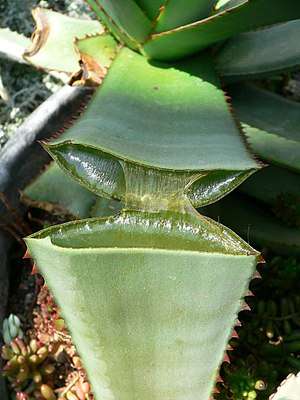
The APG IV system (2016) places the genus in the family Asphodelaceae, subfamily Asphodeloideae. Within the subfamily it may be placed in the tribe Aloeae.[5] In the past, it has been assigned to the family Aloaceae (now included in the Asphodeloidae) or to a broadly circumscribed family Liliaceae (the lily family). The plant Agave americana, which is sometimes called "American aloe", belongs to the Asparagaceae, a different family.
The genus is native to tropical and southern Africa, Madagascar, Jordan, the Arabian Peninsula, and various islands in the Indian Ocean (Mauritius, Réunion, Comoros, etc.). A few species have also become naturalized in other regions (Mediterranean, India, Australia, North and South America, Hawaiian Islands, etc.).[2]
Description
Most Aloe species have a rosette of large, thick, fleshy leaves. Aloe flowers are tubular, frequently yellow, orange, pink, or red, and are borne, densely clustered and pendant, at the apex of simple or branched, leafless stems. Many species of Aloe appear to be stemless, with the rosette growing directly at ground level; other varieties may have a branched or unbranched stem from which the fleshy leaves spring. They vary in color from grey to bright-green and are sometimes striped or mottled. Some aloes native to South Africa are tree-like (arborescent).[6]
Systematics
The APG IV system (2016) places the genus in the family Asphodelaceae, subfamily Asphodeloideae.[5] In the past it has also been assigned to the families Liliaceae and Aloeaceae, as well as the family Asphodelaceae sensu stricto, before this was merged into the Asphodelaceae sensu lato.
The circumscription of the genus has varied widely. Many genera, such as Lomatophyllum,[7] have been brought into synonymy. Species at one time placed in Aloe, such as Agave americana, have been moved to other genera.[8] Molecular phylogenetic studies, particularly from 2010 onwards, suggested that as then circumscribed, Aloe was not monophyletic and should be divided into more tightly defined genera. In 2014, John Charles Manning and coworkers produced a phylogeny in which Aloe was divided into six genera: Aloidendron, Kumara, Aloiampelos, Aloe, Aristaloe and Gonialoe.[9]
Species
Over 500 species are accepted in the genus Aloe, plus even more synonyms and unresolved species, subspecies, varieties, and hybrids. Some of the accepted species are:[3]
- Aloe aculeata Pole-Evans
- Aloe africana Mill.
- Aloe albida (Stapf) Reynolds
- Aloe albiflora Guillaumin
- Aloe arborescens Mill.
- Aloe arenicola Reynolds
- Aloe argenticauda Merxm. & Giess
- Aloe bakeri Scott-Elliot
- Aloe ballii Reynolds
- Aloe ballyi Reynolds
- Aloe brevifolia Mill.
- Aloe broomii Schönland
- Aloe buettneri A.Berger
- Aloe camperi Schweinf.
- Aloe capitata Baker
- Aloe comosa Marloth & A.Berger
- Aloe cooperi Baker
- Aloe corallina Verd.
- Aloe dewinteri Giess ex Borman & Hardy
- Aloe erinacea D.S.Hardy
- Aloe excelsa A.Berger
- Aloe ferox Mill.
- Aloe forbesii Balf.f.
- Aloe helenae Danguy
- Aloe hereroensis Engl.
- Aloe inermis Forssk.
- Aloe inyangensis Christian
- Aloe jawiyon S.J.Christie, D.P.Hannon & Oakman ex A.G.Mill.
- Aloe jucunda Reynolds
- Aloe khamiesensis Pillans
- Aloe kilifiensis Christian
- Aloe maculata All.
- Aloe marlothii A.Berger
- Aloe mubendiensis Christian
- Aloe namibensis Giess
- Aloe nyeriensis Christian & I.Verd.
- Aloe pearsonii Schönland
- Aloe peglerae Schönland
- Aloe perfoliata L.
- Aloe perryi Baker
- Aloe petricola Pole-Evans
- Aloe polyphylla Pillans
- Aloe rauhii Reynolds
- Aloe reynoldsii Letty
- Aloe scobinifolia Reynolds & Bally
- Aloe sinkatana Reynolds
- Aloe squarrosa Baker ex Balf.f.
- Aloe striata Haw.
- Aloe succotrina Lam.
- Aloe suzannae Decary
- Aloe thraskii Baker
- Aloe vera (L.) Burm.f.
- Aloe viridiflora Reynolds
- Aloe wildii (Reynolds) Reynolds
In addition to the species and hybrids between species within the genus, several hybrids with other genera have been created in cultivation, such as between Aloe and Gasteria (×Gasteraloe), and between Aloe and Astroloba (×Aloloba).
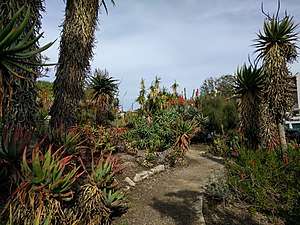
Uses
Aloe species are frequently cultivated as ornamental plants both in gardens and in pots. Many aloe species are highly decorative and are valued by collectors of succulents. Aloe vera is used both internally and externally on humans as folk or alternative medicine. The plants can also be made into types of special soaps or used in other skin care products (see natural skin care).
Numerous cultivars with mixed or uncertain parentage are grown. Of these, Aloe ‘Lizard Lips’ has gained the Royal Horticultural Society’s Award of Garden Merit.[10]
Historical uses
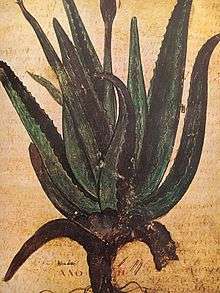
Historical use of various aloe species is well documented. Documentation of the clinical effectiveness is available, although relatively limited.[4][12]
Of the 500+ species, only a few were used traditionally as herbal medicines, Aloe vera again being the most commonly used species. Also included are A. perryi and A. ferox. The Ancient Greeks and Romans used Aloe vera to treat wounds. In the Middle Ages, the yellowish liquid found inside the leaves was favored as a purgative.[11] Unprocessed aloe that contains aloin is generally used as a laxative, whereas processed juice does not usually contain significant aloin.[13]
Some species, particularly Aloe vera, are used in alternative medicine and first aid. Both the translucent inner pulp and the resinous yellow aloin from wounding the aloe plant are used externally for skin discomforts. As an herbal medicine, Aloe vera juice is commonly used internally for digestive discomfort.[14][15]
According to Cancer Research UK, a potentially deadly product called T-UP is made of concentrated aloe, and promoted as a cancer cure. They say "there is currently no evidence that aloe products can help to prevent or treat cancer in humans".[16]
Aloin in OTC laxative products
On May 9, 2002, the US Food and Drug Administration issued a final rule banning the use of aloin, the yellow sap of the aloe plant, for use as a laxative ingredient in over-the-counter drug products.[17] Most aloe juices today do not contain significant aloin.
Chemical properties
According to W. A. Shenstone, two classes of aloins are recognized: (1) nataloins, which yield picric and oxalic acids with nitric acid, and do not give a red coloration with nitric acid; and (2) barbaloins, which yield aloetic acid (C7H2N3O5), chrysammic acid (C7H2N2O6), picric and oxalic acids with nitric acid, being reddened by the acid. This second group may be divided into a-barbaloins, obtained from Barbados Aloe, and reddened in the cold, and b-barbaloins, obtained from Aloe Socotrina and Zanzibar Aloe, reddened by ordinary nitric acid only when warmed or by fuming acid in the cold. Nataloin (2C17H13O7·H2O) forms bright-yellow scales, barbaloin (C17H18O7) prismatic crystals. Aloe species also contain a trace of volatile oil, to which their odour is due.
Flavoring
Aloe perryi, A. barbadensis, A. ferox, and hybrids of this species with A. africana and A. spicata are listed as natural flavoring substances in the US government Electronic Code of Federal Regulations.[18] Aloe socotrina is said to be used in yellow Chartreuse.[19]
Heraldic occurrence
Aloe rubrolutea occurs as a charge in heraldry, for example in the Civic Heraldry of Namibia.[20]
Gallery
.jpg) Aloe vossii
Aloe vossii A. rubroviolacea
A. rubroviolacea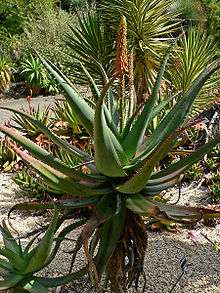 Aloe africana (Uitenhage aloe)
Aloe africana (Uitenhage aloe) Aloe marlothii (flat-flowered aloe)
Aloe marlothii (flat-flowered aloe).jpg) Aloe pluridens (French aloe)
Aloe pluridens (French aloe)- Aloe excelsa (Zimbabwe aloe)
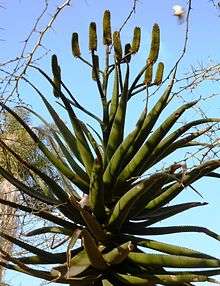 Aloe rupestris (bottlebrush aloe)
Aloe rupestris (bottlebrush aloe)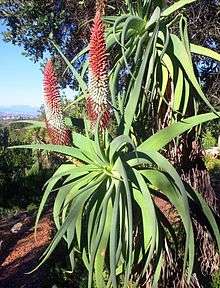 Aloe hexapetala (tilt-headed aloe)
Aloe hexapetala (tilt-headed aloe) Blooming Aloe arborescens
Blooming Aloe arborescens- Aloe cooperi (Aloe plicatilis in background on the right)

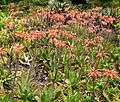 Aloe maculata - prev. A. saponaria (soap aloe)
Aloe maculata - prev. A. saponaria (soap aloe) Aloe reitzii
Aloe reitzii Room aloe
Room aloe
See also
- List of Aloe species
- List of ineffective cancer treatments
- List of Southern African indigenous trees
References
- 1897 illustration from Franz Eugen Köhler, Köhler's Medizinal-Pflanzen
- "Aloe". World Checklist of Selected Plant Families. Royal Botanic Gardens, Kew. Retrieved 2013-02-25.
- The Plant List (2010). Version 1. Published on the Internet; http://www.theplantlist.org/ (accessed July 2013)
- "Aloe Vera: Science and Safety". NIH National Center for Complementary and Integrative Health. April 2012. Retrieved 31 March 2013.
- Stevens, P.F. (2001 onwards), "Asphodelaceae", Angiosperm Phylogeny Website, retrieved 2016-06-09
- Rodd, Tony; Stackhouse, Jennifer (2008). Trees: a Visual Guide. Berkeley: University of California Press. p. 131. ISBN 9780520256507.
- "Lomatophyllum". World Checklist of Selected Plant Families. Royal Botanic Gardens, Kew. Retrieved 2013-02-25.
- "Aloe americana". World Checklist of Selected Plant Families. Royal Botanic Gardens, Kew. Retrieved 2013-02-25.
- Manning, John; Boatwright, James S.; Daru, Barnabas H.; Maurin, Olivier & Bank, Michelle van der (2014). "A Molecular Phylogeny and Generic Classification of Asphodelaceae Subfamily Alooideae: A Final Resolution of the Prickly Issue of Polyphyly in the Alooids?". Systematic Botany. 39 (1): 55–74. doi:10.1600/036364414X678044.
- "RHS Plantfinder - Aloe 'Lizard Lips'". Royal Horticultural Society. 2012. Retrieved 5 January 2018.
- Folio 15 Juliana Anicia Codex
- Tom Reynolds, ed. (2004). Aloes: the Genus Aloe. Boca Raton: CRC Press. ISBN 978-0-415-30672-0.
- "Aloe Vera Juice - How to Make it and its Side Effects". November 20, 2015.
- Wong, Cathy (September 15, 2012). "Heartburn Remedies". About.com.
- "Aloe IBS study".
- "Aloe". Cancer Research UK. Retrieved 30 August 2013.
- Food Drug Administration, HHS (2002). "Status of certain additional over-the-counter drug category II and III active ingredients. Final rule". Fed Regist. Food and Drug Administration, HHS. 67 (90): 31125–7. PMID 12001972.
- §172.510 Natural flavoring substances and natural substances used in conjunction with flavors e-CFR
- John Tellman (1900) The Practical Hotel Steward, The Hotel Monthly, Chicago
- "Civic Heraldry of Namibia". Heraldry of the World. Ralf Hartemink. Archived from the original on 27 December 2007. Retrieved 31 March 2013.
Further reading
- Carter, Susan (2011). Aloes : the definitive guide. British Cactus and Succulent Society. Richmond, Surrey, UK: Kew Pub. ISBN 9781842464397. OCLC 670480354.
- Ben-Erik, Van Wyk; Smith, Gideon (2014). Guide to the aloes of South Africa (Third ed.). Pretoria, South Africa. ISBN 9781920217389. OCLC 897036340.
External links
| Wikimedia Commons has media related to Aloe. |
- Dressler, S.; Schmidt, M. & Zizka, G. (2014). "Aloe". African plants – a Photo Guide. Frankfurt/Main: Forschungsinstitut Senckenberg.